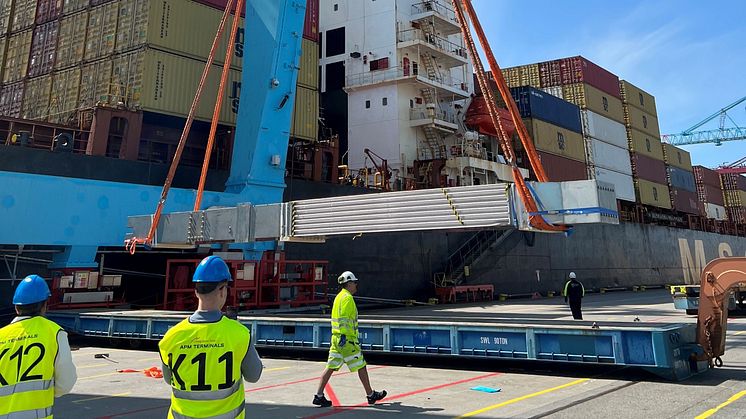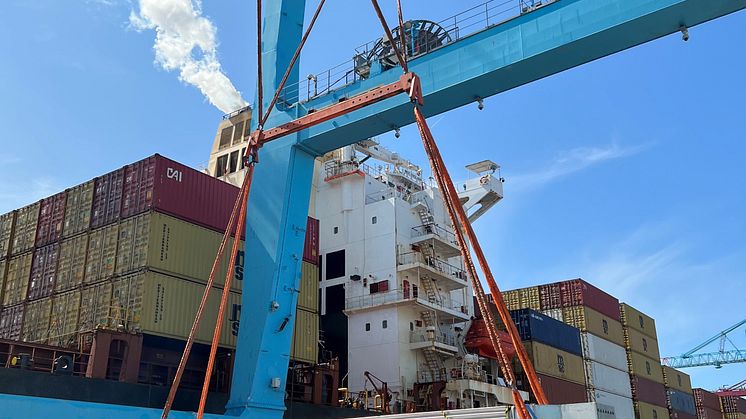
Press release -
More than "just" containers on container ships
Even if container ships are optimized to handle containers in particular, there are nevertheless good opportunities to ship so-called breakbulk cargo far beyond the limitations of what can fit in a container. Not least on board the very largest container ships offering direct liner service between the Port of Gothenburg and ports in Asia and North America every week.
“We notice that more and more people are discovering the possibility. It's nice to see that we can expand our customer base and thus also allow them to take advantage of our liner network and see that it is perfectly possible to load and unload almost anything on a container ship,” says Marco Cicola, responsible for breakbulk segment at the shipping company MSC Sweden.
The opportunities using container vessels are numerous. Depending on the size of the ship, cargo can be up to 40 meters in length and up to 12 meters in width. The largest ships that sail directly between Gothenburg and Asia each week are close to 60 meters wide and can load breakbulk cargo of around 40 meters in length. The cranes on the land side at APM Terminals Gothenburg are able to handle cargo of up to 100 tons.
This means that large and heavy breakbulk cargo in the form of e.g., transformers, construction machinery, large inputs for the steel industry are not only possible, but also actual examples of breakbulk cargo shipped to and from the Port of Gothenburg on container ships.
At the Port of Gothenburg and through the various terminals within the port area, there are plenty of possibilities to load and unload breakbulk cargo. The most common approach is to roll the goods on or off the ships at the port's RO/RO terminals, however this is not the only option, as Richard Mellgren, Senior Business Development Manager at Gothenburg Port Authority explains:
“It is becoming increasingly common to ship breakbulk cargo on container vessels, and it is a good complement for container shipping lines. For project cargo customers, this means that they gain access to an overall broader range of options at the port – especially when it comes to direct calls to Asia and North America.”
“Due to the specialist nature of project cargo, each breakbulk and out-of-gauge shipment is considered on a case-by-case basis, tailoring the solutions around the customers’ unique requirements and using our global service network to deliver their cargo anywhere in the world,” said Richard Mellgren.
Marco Cicola concludes: “As customers begin to focus more intently on sustainability, transport solutions at sea are becoming increasingly interesting, even for project loads. Moving transport from land to sea is a good way for customers to reduce their carbon footprint, and it can also prove cost-effective, so they are more and more open to new solutions that make this possible.”
Facts: Breakbulk with MSC in the Port of Gothenburg
Departures: 1/w to and from Asia + 1/w to and from North America + 1/w to and from Antwerp.
Destinations in Asia on direct service: Singapore, Shanghai, Dalian, Xingang, Busan, Ningbo. Destinations in North America: New York, Philadelphia, Norfolk, Jacksonville.
Other destinations: Worldwide with transshipment in Antwerp.
Load dimensions: Max 40 x 12 meters.
Load weight: Up to 100 tons.
Topics
Fact file: Port of Gothenburg
The Port of Gothenburg is the largest port in Scandinavia. Around 30% of Swedish domestic and foreign trade passes through the Port of Gothenburg and over 50% of all container traffic. The port is a full-service port, and offers industry guaranteed, climate-smart access to the whole world. Direct services to key markets ensure highly efficient, sustainable, and reliable transport 24 hours a day, 365 days a year. The focus is firmly on sustainability, innovation, and digitalisation in a concerted effort to maintain the ongoing development of climate-efficient freight transport and calls by vessels. With over 30 rail shuttles offering daily departures, companies throughout Sweden and Norway have a direct, climate-neutral service to the Port of Gothenburg. The port handles energy products, vehicles, ro-ro units, containers and passengers. 22,000 people are employed at the port.
Follow us on:
Facebook
Instagram
LinkedIn
Twitter
www.portofgothenburg.com





